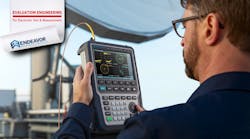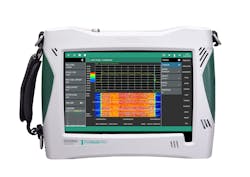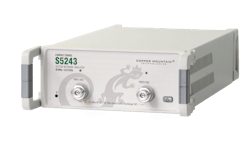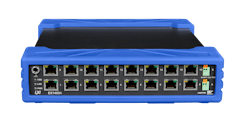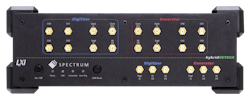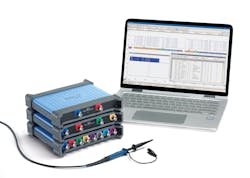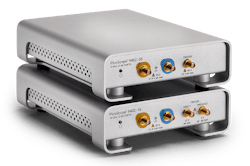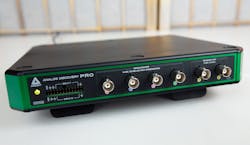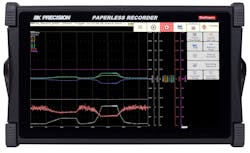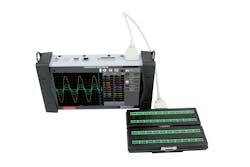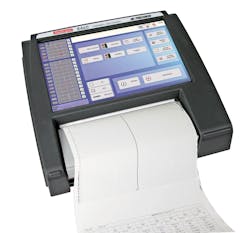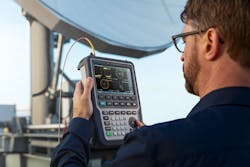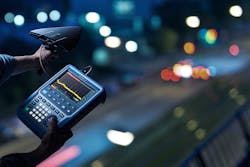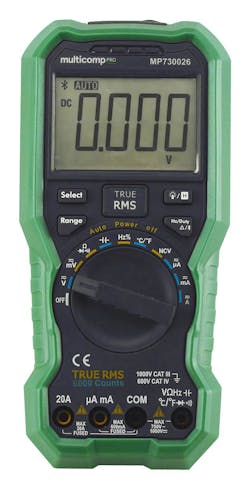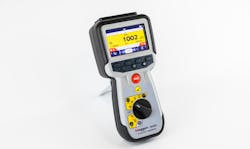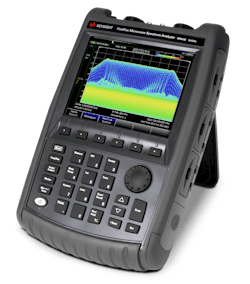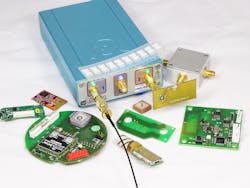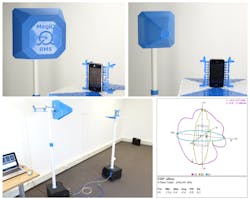This article appeared in Evaluation Engineering and has been published here with permission.
As long as electronic devices and products have existed, there has been a need to test and evaluate them for performance, safety, compliance, and reliability. Portable equipment to perform this function has grown in functionality and ability, along with the devices and application areas addressed. Here is a collection of some of the most recent releases in the portable device space.
Performing in the Cloud
Being able to connect and operate in a Cloud-enabled environment is becoming more and more important to devices that need to operate in the field. When we reached out to Anritsu about their efforts in the space, Danny Gonzalez, the company’s market development manager, gave us their Network Master Pro MT1040A 400G, a compact, battery-operated, field-portable, handheld 400G Ethernet Transport tester with full cloud-based remote-control options to test any part of the network (Fig. 1).
The MT1040A offers dual-port 400G support with available OSFP and QSFP-DD enabled hardware. It can be used to verify network equipment and interconnect performance, including throughput, latency, bit error rate (BER), service and application performance. It also has real-time RS-FEC decoding and correctable error monitor features, so it is well-suited for verifying forward error correction (FEC). It is extremely versatile, as OTDR, OLTS, or Fiber Inspection capability can all be added to a single unit.
Angus Robinson, Anritsu’s product marketing manager, brought up the company’s recently launched Field Master Pro MS2090A, a high-specification field-portable spectrum analyzer that covers up to 54 GHz (Fig. 2). The hardware has been designed to support over 100 MHz of measurement bandwidth to enable 5G New Radio (NR) measurements, as well as high-speed IQ streaming at full bandwidth for detailed post processing of all signals by government agencies and security services.
The MS2090A includes a full-span spectrum analyzer and a 110-MHz real-time spectrum analyzer (RTSA). With an RTSA, users are able to see signals never-before captured in a field environment because their duration was too short, or they were buried underneath other higher-powered signals. Other measurements supported on this instrument include automated radar pulse analysis, coverage mapping and EMF measurements.
Addressing Issues
When it came to some of the key challenges their customers were facing, the team explained that service providers are all deploying field-ready, high-speed computing devices deeper into the edge, to reduce latency and distribute data resources for Mobile Edge Computing (MEC), Virtual RAN (vRAN), Open RAN (ORAN) and OTT streaming resources. The portable MT1040A Network Master Pro 400G enables field installation, turn-up, performance verification, and troubleshooting of high-speed computing devices deployed anywhere in the network, from core to edge, and anywhere in-between.
As the spectrum becomes more crowded with new frequency bands allocated to cellular and LMR networks, interference between networks becomes a bigger challenge. Monitoring for interference and then locating its source and mitigating it requires a range of tools. When spectrum is re-assigned by the government, such as the recent 600-MHz spectrum migration from broadcast TV to cellular, the new spectrum owner needs to validate that all legacy users have shut down.
Continuous spectrum monitoring is required to identify new sources of interference that will degrade network performance. If new interferers are found, tools are required to pinpoint their location and identify the most likely source. Typically, this will require directional antennas, signal demodulation, RTSA for finding signal in signal interferers and even IQ capture for offline analysis of the most evasive signals. The MS2090A is an example of such a solution that meets all these needs.
When asked about what the company was seeing in the area of handheld & portable instruments, the response was about the drive to support cloud-based remote control and monitoring capabilities. This includes products like tablets and smart devices, regardless of deployment environment. There is also a need for built-in automation capability to develop custom test procedures unique for each customer application.
Security is becoming a necessity, as well. Handheld instruments are being built on Linux OS platforms with built-in security and firewall measures to prevent tampering or unlicensed user access, malware or virus corruption. Finally, they need an all-in-one approach with a scalable platform which can be hardware-configured in the field without service or manufacturer support required.
In the Field
When it came to primary application areas served, Gonzalez pointed out how the MT1040A is used by service providers for complete fiber to the antenna (FTTA); mobile fronthaul and backhaul; Metro and Core network installation and maintenance, while having benchmark testing capabilities. Multi-Access Edge Computing (MEC), co-lo, and hyperscale data-center operators are using the MT1040A for interoperability field testing for AOC, DAC and L2/L3 network hardware environments. It is also Tier 1 wireless and wireline operator-approved for 5G CRAN/ backhaul I&M with formatted closeout package reporting.
Robinson brought up that as a spectrum analyzer, the MS2090A serves a wide range of field applications, like cellular and LMR transmitter performance validation, with 5G and LTE modulation analysis built in. It also offers network coverage mapping, with a drive test for signal strength plotted onto digital maps fully integrated into the platform. It also provides pulse and radar measurement analysis, compliant to IEEE pulse specifications. Interference hunting, with RTSA, demods, and direction-finding all built in. IQ data capture provides a 110-MHz bandwidth, that can be continuously streamed in real time for offline post-processing.
Digital circuitry is moving closer to the instrument RF input. This is enabled by advances in ADC/DAC technology. The need for exceptional RF performance, however—especially spurious -free dynamic range—limits how close to the RF front-end digital technology can be designed. High-performance FPGAs are now required in handheld instruments to enable features such as RTSA and 5G demodulations. Instruments are becoming more multifunctional, as users demand more capability from their field and handheld test solution. Performance previously reserved for benchtop instruments used in a lab environment is now available in handheld field portable instruments.
Portability for High-Frequency Test
Subbaiah Pemmaiah, application engineer lead for Copper Mountain Technologies (CMT), was very bullish on the addition of the S5243 Vector Network Analyzer (VNA) to the Compact family. This metrology-grade analyzer covers frequencies up to 44 GHz and yet is very lightweight and compact, making it a suitable portable instrument for high-frequency measurements (Fig. 3).
Some of the key features of the VNA include a frequency range: 10 MHz to 44 GHz, an output power range from -50 to 0 dBm, a measurement speed per point of 17 μs (at 1-MHz IFBW), a dynamic range of 130 dB typical (at 10 Hz IFBW), and a maximum frequency points per sweep of 500,001.
As modern testing requirements continue to evolve, there is a need for a wide-frequency VNA to perform measurements on various bands, for example in the 5G space. The recently introduced S5243 VNA addresses this need by being one instrument to cover wide-frequency tests. This VNA also comes with frequency offset (for scalar mixer measurement), and a vector-mixer calibration method, as standard features to support mixer and converter measurements, which are essential in modern designs.
The modular approach of having USB-based equipment is trending in the test and measurement industry, pivoting to the use of low-cost single-board computers to run the software, thereby reducing the overall footprint of the test systems. Another example can be found in the Compact and 1-Port (Reflectometer) series of CMT VNAs that are versatile solutions well-suited for specialists working in the field, as well as laboratory and production testing in industries from medical devices to aerospace.
All CMT VNAs are USB-based without a built-in computer, separating the measurement module (VNA) from the processing module (PC), allowing the user to take advantage of the latest processors available in them, and yet not compromise on the measurement accuracy. With the elimination of the built-in PC, these analyzers are also much smaller and lighter compared to legacy analyzers.
Useful in Both Lab and Field
For some, being able to afford both portable and lab instruments is a high hurdle to jump. Chris Gibson, VTI Instruments’ senior product manager, highlighted one of the company’s latest product families, that currently includes two instruments that operate rack-mounted in a traditional test-and-measurement environment, or as a more portable instrument able to operate in a wide variety of situations. The EX1401 is for isolated voltage and thermocouple measurements, and the EX1403A is for strain, bridge, and voltage/resistance measurements (Fig. 4).
Both use Ethernet/LXI as the control interface, but provide for several options for power, which includes AC, DC, or POE+. This lets users distribute the instruments, reducing setup time, cabling cost, and clutter. Both instruments also support IEEE 1588/PTP to provide instrument-to-instrument synchronization, as well as highly accurate data time-stamping.
Addressing Challenges
Gibson pointed out that connection challenges are an industry issue, and that providing a solution that is easy to connect to, with tools to help troubleshoot connection issues, is critical. Cabling and connectors continue to be a large recurring expense, so using lower-cost easy-to-use connectors can reduce overall testing costs. Eliminating terminal blocks also allows direct connection to allow last min changes quickly and easily. TEDs can also be used to reduce connection issues and speed setup.
The company believes that devices will continue to become smaller in size and more portable without sacrifice in performance. In addition, they see a change in the way instruments communicate that information back to the user. While Ethernet allows users to move data via standard wired TCP/IP protocols, it also allows for the ability to move data wirelessly using standard wireless Ethernet protocols. Customers are also asking for newer IoT-type communication protocols like DDS (Data Distribution Service), to address challenges with data latency and determinism, while improving the ability to distribute measurements.
Gibson explained that the primary application areas he sees in handheld & portable instruments serve include desktop laboratory measurements, test cells, wind tunnels, dynos, and traditional rack/stack applications. The company also encounters a lot of automotive test-cell applications as well as in-vehicle testing, along with structural and fatigue testing, wind and turbine-test tunnels, and civil structures testing.
As the industry migrates forward, VTI Instruments is leveraging a variety of technologies and standards, such as LXI/Ethernet for instrument grade communications, IEEE 1588/PTP for timing and synchronization, and POE to make it easier to be able to distribute measurements. Built-in intelligence is also provided to provide Engineering Unit conversion in real-time on the measurement instrument, along with TEDs or Smart Transducer support.
Multitasking in the Field
Oliver Rovini, technical director at Spectrum Instrumentation, was pleased to describe their recently introduced hybridNETBOX, a family of portable instruments with the ability to create as well as acquire electronic signals at the same time. 14 models are available, with 2+2, 4+4 or 8+8 matched generator (AWG) and digitizer channels, in the speed range of 40 MS/s to 1.25 GS/s, all 16-bit (Fig. 5).
The products are great for measurement systems that need to perform automated closed-loop or stimulus-response type testing. For example, they can reproduce and capture “echo” signals such as those found in radar, sonar, LiDAR, or ultrasound. With their multichannel capability, they can test these systems even when arrays of transmitters and receivers are used.
One big challenge the company sees today is that analog and digital signals must be measured at the same time. To offer such mixed-mode situations, they launched a digital option with 11 digital inputs for the portable digitizer NETBOX-products, along with 8 analog channels. All 19 channels work fully synchronously. The digital option is also available for most of their PCIe digitizer and AWG cards, so more than 50% of Spectrum Instrumentation’s products are ready for mixed-mode.
Rovini explained that Spectrum products are general-purpose instruments, used in nearly every application area, with customers using their portable digitizers and generators for everything from LiDAR, radar, and sonar, to astronomy, quantum science, and big physics experiments like particle accelerators. Universities are a big user area, with different test-and-measurement requirements, but like all customers they want high quality and fast support.
Spectrum’s portable instruments follow the LXI standard to allow a maximum interoperability with other measurement equipment and software. The standard Ethernet interface allows control of these instruments from any laptop or desktop PC via the company LAN or via a direct connection.
High-Resolution Test
When we talked to Trevor Smith, business development manager at Pico Technology, he touted their latest PC-based PicoScope series products. Their PicoScope 4000A Series of high-resolution, deep-memory portable oscilloscopes offer 2-, 4- and 8-channel models (Fig. 6). The PicoScope 4000A Series boasts 12-bit hardware resolution (to 16 bits with Resolution Enhancement), 256-MS deep capture memory, and a 20-MHz bandwidth with an 80-MS/s sampling speed, up to 70-dB SFDR, a built-in 14-bit triggerable signal generator, and 80-MS/s AWG.
The PicoScope 9400 Series 5- and 16-GHz SXRTO (Sampler eXtended Real Time Oscilloscope) add 2-channel models to the 4-channel models previously announced. Each channel has 12-bit resolution, real-time sampling to 500 MS/s per channel, and up to 1 TS/s (1 ps) equivalent-time sampling (ETS).
The diversity of measurements that need to be made by electronics engineers creates a huge challenge in today’s environment. An engineer debugging high-speed logic signals one day might be called upon to run a long-duration soak test the following day and check for immunity to power harmonics the next. They need tools that span the range of tasks they are expected to address with the minimum of fuss.
Smith brought up how lockdowns of regular workplaces caused by Covid-19 have made those challenges more difficult, as conventional benchtop test equipment doesn’t fit comfortably on a dining room table. (And is unpopular with other people in the household who want to use the table for schoolwork or ... dining!). With engineers forced to work from home in some degree of isolation, it is also difficult to share the equipment. Versatile low-cost PC-based instruments are affordable per-engineer, enabling teams to share results and continue their work at-pace.
The Covid-19 pandemic has further accelerated the adoption of PC-based instruments such as PicoScope, Pico dataloggers, and Pico RF test equipment. The PicoScope 9400 Series 5 GHz and 16 GHz oscilloscopes enable serious signal-integrity work to be done in the home-work environment (Fig. 7). PicoScope PC-based instruments are used across a huge range of applications, including digital design debug, analog circuit behavior, power analysis, transfer function characterization, and many other electronic design verification applications.
Portability with Customizability
When we asked Kaitlyn Franz, test and measurement product manager at Digilent, about their latest handheld and portable instruments, she told us about their Analog Discovery Pro line of products, the ADP3450. While the Analog Discovery focuses on portability, the Analog Discovery Pro enhances customizability, and enters a higher specification level, to better meet the needs of engineers being forced out of the labs and into their homes.
Linux Mode provides an on-device operating system that, when combined with WaveForms SDK, is a flexible jumping off point for all kinds of custom tests and applications. As a classic demonstration each operation Mode of the device, I have two test and measurement takes on the classic LED blink example: an automated test of an ADC, and a very simple power measurement demonstration.
The ADP3450 defaults into Standard Mode, which allows you to connect via USB or Ethernet to a computer running WaveForms to take quick measurements as you would on any standard USB oscilloscope or logic analyzer (Fig. 8). Booting into Linux Mode is as simple as changing the boot mode setting. Once booted, a terminal application can be used to connect to the serial port of the device. For this example, Python can be used to write, although several other languages can be used as well to write scripts.
In today’s working environment, having access to an entire lab’s worth of test equipment, and being able to use it whenever and wherever they need, is a big challenge. With the removal of access to the lab in many areas, these portable instruments are being required to function on a higher level to address the entire design and test cycle. Things like noise, mixed-signal systems, and resolution will need to be addressed by portable instruments. The ADP3450 introduces a hardware bandwidth filter in addition to the many software filters, uses high-resolution ADCs and DACs, with dedicated triggers and digital I/O to address these challenges.
According to Franz, one of the trends they’ve noticed is that standalone devices increasingly have software interfaces available, often as an extra purchase. The ADP3450, while larger than the Analog Discovery, introduces an on-device terminal-based operating system, enabling tests to be run standalone on the device. One of the key issues with this trend is ease of use, consistency, and reliability among the interfaces, keeping them separate and stable, but easy to switch back and forth.
Digilent’s instruments are flexible and portable multi-instrument devices, easily configured by software to meet a wide variety of needs. For example, on the Analog Discovery 2, the power supplies can be configured as additional AWGs, and the triggers can be configured as inputs or outputs, as the application demands it. This also provides the ability to provide ample Digital I/O making the devices true Mixed signal oscilloscopes.
The company’s next generation of devices, the Analog Discovery Pro, will take that to the next level, with SoCs from Xilinx, adding a processor and the ability to run an on-device operating system on the devices. Franz emphasized that their design ensures that the addition of the operating system does not sacrifice the core functionality of the instrument.
Keeping the Data
David Holt, senior director of sales and marketing at B&K Precision, reminds us that with all the emphasis on data capture, that information must be rapidly and extensively stored so it may be properly used. Recently the company announced two additions to their portable data recorder line with the DAS1700 (Fig. 9) and 8460. These configurable data-acquisition systems feature a fast sampling interval of 1 µs (1 MS/s) and four types of measurement boards. A wide input range (±5 mV to ±1000 V) and a large internal solid-state memory of up to 2 TB are also included.
The boards include universal, high-voltage, strain gauge, and multiplexed input types. The 8460 supports any combination of up to three boards, while the DAS1700 features an optional extension module for up to six boards. The 8460 also offers a built-in printer for permanent data records. Customers often need an instrument that can measure and record over an extended period, typically with several channels and sensor types.
The ability to quickly configure the instrument while in the field is critical, and all their data recorders feature on-screen interactive guides to help the user. The DAS240 Series can support up to 200 field sensors, and addresses the dressing and landing wires for sensors each time the recorder is moved by offering a passive connector module that can be prewired and left at multiple locations (Fig. 10).
Users of portable instruments working in process control and data acquisition gather hours of field data that can require additional post-processing using complex math. The DAS1700 recorder includes math functions that can be modified with the onscreen editor. The resulting complex math function product is displayed on what B&K Precision calls a "virtual channel." This makes it easy for the operator to optimize the recordings while in the field. The built-in math functions and onscreen editor can save customers hours of post-processing time and return trips.
Holt pointed out that B&K Precision data recorders are excellent for capturing data where several sensors are needed. Multichannel capabilities are often used in aerospace, energy, railroad, and environmental research. In some industries, regulatory agencies require event recording with printed hard copy. The 8460 serves this application with a built-in printer (Fig. 11).
Data recorders require periodic improvements in hardware and software to meet changing industry demands, and David said their design team leverages the latest semiconductor technology in power devices and signal processing. Opportunities in new energy will require data acquisition solutions ranging from battery operated recorders like their DAS220 to high-speed and configurable DAS1700 data acquisition systems for single and multiphase analysis with user-defined math functions.
Cost-Effective Solutions
At Rohde & Schwarz, we spoke with Matt Maxwell, spectrum and signal analyzer product manager, and Rich Markley, distribution product manager. Their R&S ZNH handheld 2-port VNA has capabilities that can often only be found in benchtop VNAs, like 16,001 measurement points, while being competitively priced (Fig. 12). Maxwell mentioned how in October 2018, the company launched the microwave versions of their R&S FPH handheld spectrum analyzer, with size, weight, power, and durability advantages. At 5.5 lbs., with an 8-hour battery life and a fanless design, it covers up to 31 GHz.
One of the biggest challenges customers face when using handheld equipment is battery life. They’re often out in the field for an extended period of time, and nothing is more painful than having a battery die on you when you’re at the top of a tower making measurements. Markley said that’s why they pay special attention to delivering a long battery life. Ease of use is another challenge. Having a device that requires a dozen button pushes to make a measurement is a challenge. R&S designed their interfaces in a way that in many cases, the most common measurements used by customers are easy to access and fast.
In the area of trends, Markley said that in test they were similar to trends in other areas, with bigger, higher-resolution touch-screen displays, while also maintaining the ability to use gloves via buttons if needed. RF performance that has often been reserved for benchtop instruments is also making its way into handhelds. Maxwell added that they also see a trend for higher frequency ranges and improvements in size, weight and power.
Among the application areas R&S instruments serve, Maxwell used satellite monitoring as an example, as a high performance, low-cost spectrum analyzer is suitable to help monitor satellite signals up to 31 GHz. In interference hunting, a lightweight, high performance spectrum analyzer helps identify signals of interest and resolve interference issues. Maximum operating time, sunlight viewable screen and light weight help make sure there is enough time to find the root cause of signal interference issues.
EMI troubleshooting is one area where there are times when a benchtop instrument won’t work, as finding EMI issues on a device in a testing chamber or in the field can sometimes be invaluable to getting to find the root cause. For example, the high-performance R&S FPH has a dedicated receiver mode with Quasi-Peak detector to help you detect and isolate the source of EMI problems in real world operating environments (Fig. 13).
A Variety of Offerings
A distributor like Newark is another way to find the right solution. For example, they are the exclusive distributor of the Multicomp Pro line of products, and they sent us information on two of their latest handheld and portable instruments available. The Multicomp Pro USB Oscilloscope (MP720646 US) is a 100-MHz, 2-channel portable PC oscilloscope with a built-in 5-MHz signal generator with a 500-MS/s sampling rate; 8-, 12-, and 14-bit vertical resolution; as well as a maximum 10M record length. This portable oscilloscope is a can be a cost-effective solution for students studying from home and engineers working in the field.
Newark’s Multicomp Pro range also includes the MP730026 US handheld digital multimeter with thermometer, datalogger, and Bluetooth function. The MP730026 is a true RMS DMM that measures AC/DC current up to 20 A, AC voltage up to 750 V, DC voltage up to 1 kV, capacitance, diode, duty cycle, frequency, resistance, and temperature from -50°C to +400°C. The datalogging and Bluetooth options make this DMM suitable for remotely monitoring temperatures in potentially hazardous environments (Fig. 14).
This past year, the key challenges for test equipment used have been primarily related to the COVID-19 pandemic and the subsequent restrictions that have been put in place. The restrictions have challenged customers to find test equipment that is both laboratory grade and compact enough to be used in the lab, factory, at home and other remote test sites. University technical educators and students have been especially impacted as their learning must now be done remotely.
This is a challenge for the educators in ensuring their lessons remain accessible and informative but also for the students that now require the equipment they would usually have at the campus labs in their own home. Newark is helping both students and their teachers address these challenges by providing handheld and portable instruments that are rugged and compact for remote use while also ensuring they are cost effective for students or teachers on a budget.
The market for handheld and portable instruments is demanding increased battery capacity, miniaturization of circuits to allow for smaller form factors and additional features, as well as more rugged instruments. Environment changes, safety concerns, and green engineering are driving demand for portable environmental testing as well as the addition of contemporary environmental testing features on the more traditional equipment.
The impact of the COVID-19 pandemic has led to a change in approach for almost all businesses, customers, and sectors. The changes to the way engineers test has meant that the way Newark supports them in their test needs has had to change, too. Now, Newark is focusing even more on providing portable test instruments for education; ensuring that students, teachers and educational institutions are able to continue the vital task of teaching and learning while meeting the requirements of the present day.
Reducing Repetitive Work
When we approached Megger about their latest devices, applications specialist Brian Hammerschmidt told us about the DLRO2 (Ducter Low Resistance Ohmmeter), a handheld, 2-A low-resistance ohmmeter with a “Difference Meter” for quick data comparisons (Fig. 15). This allows repetitive measurements to be easily compared with an initial reference measurement.
The DLRO2 has a dedicated long test-lead mode that optimizes the instrument to work with very long test leads, and can be used with long leads at 1 A without compromising test speed. It also has an inductive test mode with a new automatic stop when the inductance is fully charged, and can safely test the resistance of inductive loads at 1 A. It also has greater than 600 V active protection against inadvertent live connections, without blowing a fuse.
Well-suited for outdoor use, with protection against dust and moisture to IP54, the company’s instruments are used in places such as testing lightning protection on wind turbines (wing tip to ground at base resistance), which presents safety and technical challenges. This testing often involves working at significant heights (average height of U.S. wind turbines is approximately 300 feet)—so, providing lighter-weight equipment increases safety, the DLRO2 is only 2 pounds and can be clipped to a work belt.
Technical challenges include the use of very long test leads (necessary for reaching required distances)—this can limit the maximum current that the instrument can produce. The DLRO2 has a dedicated test to optimize the output for applications with long test leads. It can apply 1 A in a total resistance of up to 3 Ω, allowing potentially over 490 feet (150 meters) of test cable to be used.
Hammerschmidt emphasized the DLRO2 difference meter, which makes it easy to identify connections with slightly higher measurements that could indicate a latent fault, as small increases in resistance in a joint can lead to a future fault, with a plus and minus percentage scale along the top of the display. The first measurement becomes a 0% reference measurement, and each subsequent measurement will cause a pointer to move to indicate the percentage difference from that reference measurement. Each measurement leaves a marker on the scale, allowing an easy indication of the measurement, and noisy measurements leave a red marker.
The DLRO2 can display three test results at the same time (the current measurement and the previous two resistance measurement results) allowing fast and simple comparison of the resistance measurements of the three phases. This aids testing resistance of inductive loads such as motors, compressors, transformers, inductors, and power generators, especially in production environments.
We Did Say "Portable"
Dan Kacerovskis of SAF North America emphasized the utility of their highly-portable RF spectrum analyzer for the field engineer. The cost-effective solution from SAF Tehnika is a 6-20 GHz addition to its series of ultra-portable hand-held microwave spectrum analyzers.
In addition to their industry-leading portable E-band (70-87 GHz) and V-band (56-71 GHz) handheld spectrum analyzers, these tools help microwave engineers efficiently go about the jobs of link planning, installation, site acceptance, maintenance, and troubleshooting (Fig. 16).
The 6-20 GHz spectrum analyzer boasts a rugged, ultra-compact form factor with a simple, intuitive interface, high sensitivity (-110 dBm at RBW = 30 kHz), long battery life (up to 4 hrs), and instant-on functionality. It is a must have tool for anybody who deploys and maintains licensed microwave links. Compared with laboratory-grade equipment, Spectrum Compact devices differ both in portability and affordability.
The portfolio consists of seven devices, each covering a specific frequency range. Teams can be equipped with the frequency ranges they require instead of investing in a full range lab grade spectrum analyzer. Spectrum Compact devices serve mobile operators, carriers, and tower installation crews deploying 5G networks, as well as service providers, local institutions, and critical network infrastructure owners.
Addressing site survey, radio parameter verification, antenna alignment, interference detection, line-of-sight verification and interference hunting. Every aspect of SAF’s toolset has been designed with field use in mind, including a resistive touchscreen for operation with gloves, beefy thumbscrews for the SMA and waveguide connections, and high-contrast and fill display modes for easy readability in bright light situations. 8 GB of memory allows you to save thousands of spectrum traces for offline analysis, investigation, and reporting using the included PC software.
Multipurpose, Multifunction
Sarah Gross, the product marketing manager for FieldFox at Keysight Technologies, talked about their recently introduced FieldFox spectrum analyzers and combo analyzers, which support frequencies up to 54 GHz with 120 MHz of bandwidth (Fig. 17). The company presents the combo analyzers as the only handheld analyzers available, that can perform over 25 different measurement functions—including spectrum analysis, network analysis, base station testing, cable/antenna analysis, and more—with mmWave coverage.
High frequencies and wide bandwidths are driving the technologies of tomorrow, like multi-gigabit mobile, satellite communications, and autonomous vehicles. For these applications, customers need handheld, portable, battery-powered units that they can carry into the field and perform all the necessary tests in one trip. Having a mmWave-capable handheld analyzer that performs measurements besides just spectrum and network analysis helps to speed up troubleshooting in the field and minimize network downtime.
Gross said Keysight is seeing a shift to higher-frequency handheld devices because of the challenges posed by mmWave deployment. Especially in the network operator industry, companies are offering higher frequency coverage with wideband analysis to capture, demodulate, and test 4G, 5G, and future 6G technologies in the field.
In the Field, in the Home
Because FieldFox performs a variety of measurements in one portable, cost-effective form-factor, it can address almost any RF and microwave test environment. The company primarily sees it used in aerospace and defense applications (radar, satellite, etc.) and telecommunications (5G deployment, base station testing, etc.), but it has its places in many other industries as well. In current COVID times, Sarah sees engineers working from home and using FieldFox in lieu of their normal bench-top test equipment found in their lab at work.
Keysight has advanced RFIC design technologies integrated into FieldFox, to give its small footprint multifunction capabilities like SA, NA, RTSA, etc. These technologies also allow FieldFox to take on much higher RF power without significantly increasing power consumption. Altogether, these innovations enable them to offer a mmWave instrument with almost four-hour battery life that you can hold in one hand.
For 5G-specific base station testing, FieldFox integrates with a phased-array antenna for beamforming verification and power measurements. It is also presented as the only handheld on the market that offers phased-array antenna control to visualize beams emitted by phased-array antennas at the cell site.
Testing in a COVID World
Roger Denker, CEO of MegiQ, reinforced the other people who responded about the COVID pandemic, and how working from home requires portable instruments. MegiQ provides compact and complete VNA measurement solutions in a carrying case.
The MegiQ VNA-04x0/VNA-04x0e families are compact vector network analyzers that are used for professional antenna and network measurement and optimization. The MegiQ VNA-0460 is a 6GHz 2 port VNA, that is USB driven with PC software (Fig. 18). The MegiQ VNA-0460e is a 6-GHz, 3-port VNA, with built-in Bias-T and Bias voltage/current generator.
With a frequency range of 400 MHz to 4 GHz and 6 GHz respectively, they are well-suited for characterization and measurement of 1-, 2-, and 3-port networks such as antennas, matching networks, amplifiers, filters, power splitters etc. They cover all popular communication bands used worldwide. They can also characterize the wireless devices of today, like IoT devices, routers, phones, domotica products, electronic gadgets, tablets, laptops, and RF modules.
The MegiQ RMS-0660 portable antenna radiation measurement system covers 600 MHz to 6 GHz, performing 3-axis radiation pattern measurement in non-anechoic spaces (Fig. 19). With a frequency range of 370 or 600 MHz to 4 GHz or 6 GHz, they are well-suited for characterization and measurement of antenna radiation patterns, antenna gain, ERP, TRP, and field strength. Denker said that extensive evaluation has shown that—with reasonable setup—the accuracy of the RMS is similar to that of anechoic test labs.
The IoT market is booming. Many engineers are facing implementing very complex RF circuits and antennas, and need complete, no-nonsense, easy-to-use instruments to develop wireless applications. Denker stressed that MegiQ products focus on the measurements and the results, not merely on the equipment, with a main market in the development of wireless applications in IoT and 5G. The company’s VNA-Sandbox with tutorial makes it easy to get started with VNA measurements, and it provides a starting point for wireless product development.
